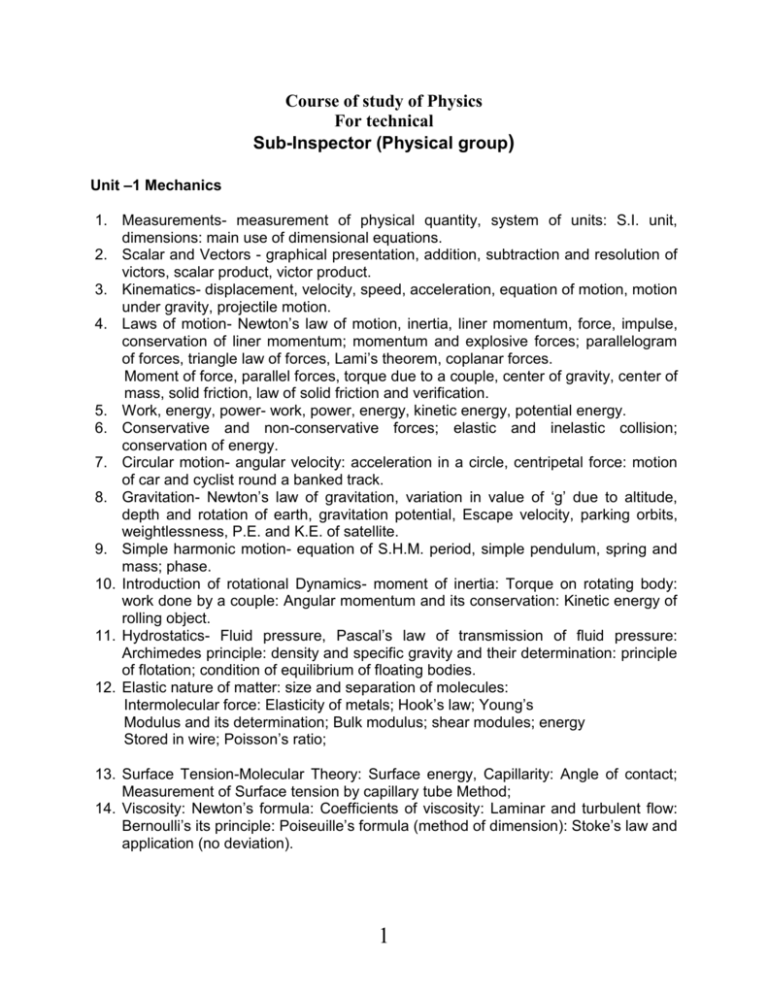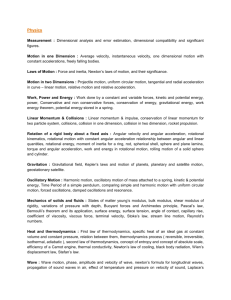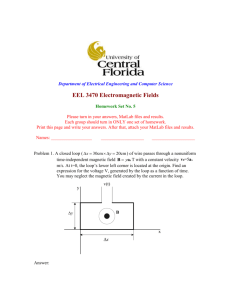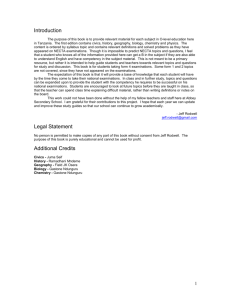1001
advertisement

Course of study of Physics For technical Sub-Inspector (Physical group) Unit –1 Mechanics 1. Measurements- measurement of physical quantity, system of units: S.I. unit, dimensions: main use of dimensional equations. 2. Scalar and Vectors - graphical presentation, addition, subtraction and resolution of victors, scalar product, victor product. 3. Kinematics- displacement, velocity, speed, acceleration, equation of motion, motion under gravity, projectile motion. 4. Laws of motion- Newton’s law of motion, inertia, liner momentum, force, impulse, conservation of liner momentum; momentum and explosive forces; parallelogram of forces, triangle law of forces, Lami’s theorem, coplanar forces. Moment of force, parallel forces, torque due to a couple, center of gravity, center of mass, solid friction, law of solid friction and verification. 5. Work, energy, power- work, power, energy, kinetic energy, potential energy. 6. Conservative and non-conservative forces; elastic and inelastic collision; conservation of energy. 7. Circular motion- angular velocity: acceleration in a circle, centripetal force: motion of car and cyclist round a banked track. 8. Gravitation- Newton’s law of gravitation, variation in value of ‘g’ due to altitude, depth and rotation of earth, gravitation potential, Escape velocity, parking orbits, weightlessness, P.E. and K.E. of satellite. 9. Simple harmonic motion- equation of S.H.M. period, simple pendulum, spring and mass; phase. 10. Introduction of rotational Dynamics- moment of inertia: Torque on rotating body: work done by a couple: Angular momentum and its conservation: Kinetic energy of rolling object. 11. Hydrostatics- Fluid pressure, Pascal’s law of transmission of fluid pressure: Archimedes principle: density and specific gravity and their determination: principle of flotation; condition of equilibrium of floating bodies. 12. Elastic nature of matter: size and separation of molecules: Intermolecular force: Elasticity of metals; Hook’s law; Young’s Modulus and its determination; Bulk modulus; shear modules; energy Stored in wire; Poisson’s ratio; 13. Surface Tension-Molecular Theory: Surface energy, Capillarity: Angle of contact; Measurement of Surface tension by capillary tube Method; 14. Viscosity: Newton’s formula: Coefficients of viscosity: Laminar and turbulent flow: Bernoulli’s its principle: Poiseuille’s formula (method of dimension): Stoke’s law and application (no deviation). 1 Unit –2 Heat 1. Temperature and heat: temperature scales: thermal equilibrium, 3eroth law. 2. Expansion- linear expansion, cubical expansions and their relation: measurement of linear expansivity, pullinger’s apparatus: Absolute and apparent expansion of liquid. 3. Heat capacity – heat capacity and specific heat capacity, Newton’s law of cooling, measurement of specific heat capacity of solids method of mixture and of liquids by the method cooling. 4. Latent heat- specific latent heat of fusion, specific latent heat of evaporation and their measurement by the method of mixture. 5. Gases – Boyle’s law: Dalton’s law of partial pressure, Charle’s law, Volume coefficient: Pressure coefficient: Absolute temperature: Equation of state, ideal gas equation: the gas contrast. 6. Kinetic theory of gas- postulates: pressure evaluation: Root mean square speed: variation of RMS speed: Boltzman constant. 7. Hygrometry- saturated and unsaturated vapors, behavior of saturated vapor: Effect of temperature: effect of attitude of boiling point: Triple point: Dew point, absolute humidity: relation humidity and its determination. 8. Transfer of heat- conduction, thermal conductivity and its determination by Searle’s method: convection: Radiation: Inverse square law: black body radiation: Stafan’s law. 9. Thermodynamics: a) first law of Thermodynamic – Work done by gas : Latent heat and internal energy; first law of thermodynamic ; Molar and specific heat capacities; Isothermal and adiabatic changes and work done. Equation of reversible adiabatic; temperature changes in adiabatic. b) Second law of thermodynamic – Heat and Work in engines; Carnot Cycle and efficiency. c) Heat engines- Petrol engine. Diesel engine and steam engine and their efficiencies with P-V diagram. Unit-3 Optics 1. Propagation of light – Rectilinear propagation: light rays and beams, 2. Photometry – luminous energy, luminous flux, luminous intensity, and illuminance: inverse square law, Lambert’s cosine law. 3. Reflection plane surface – law of reflection: Deviation of light by plane mirror and rotating mirror, image in plane mirror. 4. Reflection at curved mirror – convex and concave mirrors, narrow and wide beams, image in spherical mirrors formula, Real and virtual images. 5. Reflection at plane surface- law of reflection, refractive index, relation between refractive indices: Apparent depth: Lateral shift, total internal reflection: critical angle. 6. Reflection through prisms – refraction through prism: minimum deviation: relation between A, Dmin: RI Grazing incidence and grazing emergence. 7. Lenses- image in lenses: Deviation by small angle prism, relation between object distance, image distance and focal length for thin lenses: lens maker’s formula: thin lens in contact. 8. Dispersion- spectrum: pure spectrum: Disperse power, Deviation without disperse: disperse without deviation: Achromatic lenses: condition for achromatic lenses in correct. 2 9. Optical instruments – The human eye; defects of vision, visual angle: angular magnification: Astronomical, terrestrial and Galilean Telescope. Simple and compound microscope; Spectrometer; Camera; Spherical and chromatic aberration. 10. Wave theory of light – velocity of light. Fizeau. Focault. Method for velocity of light; wave theory of light: Huygen’s principle. Reflection and refraction according to wave theory. 11. Interference- coherent sources. Interference, optical path: young’s double slit experiment. 12. Diffraction- diffraction at single slit: diffraction pattern of image: diffraction grating 13. Polarization- polarized and unpolarized light; Brewste’s law; transverse nature of Light. Unit – 4 Magnetism. 1. Basic concepts of magnetism- coulomb’s law, Magnetic fields due to a bar magnet in the end – on position and Broadside position, Magnetic moment: Intensity of magnetization: Neutral point: Magnetic Meridian: 2. Magnetometers – Tangent law: Deflection Magnetometer and its uses: Vibration: Magnetometer and its uses. 3. Terrestrial magnetism- elements of earth magnetism and their vibration: Dip and dip circle: Dia - para and ferromagnetic materials. Unit- 5 Electrostatics 1. Fundamental electrostatics phenomena- charges: conductor and insulator: gold leaf electroscope: induction: Action of points: Ven de Graffe generator ice –pail: Experiment: surface charge density. 2. Electrostatic Field- Coulomb’s law, permitivities: electric field: Electric flux: gauss’s theorem: field due to a charged sphere and plane conductor: Electric potential: Potential Difference: Potential and energy: Electron volt: Potential gradient and electric intensity: Equipotentials. 3. Capacitors- Charging and discharging of capacitor, capacitance: facto determining capacitance, parallels plate capacitor, capacitance of isolated sphere: dielectric constant and Dielectric strength: Action of Dielectric. Unit-6 Current Electricity 1. D.C circuit- Electric current: Ohm’s experiment: Resistance: Resistance’s in series and parallel: Potential divider: Resistivity: Conversion of Milliameter into voltmeter and ammeter: Ohm’s law: mechanism of metallic conduction: Ohmic and non-ohmic conductor. 2. Heat and power- Joule’s law: electric power: potential difference and electromotive force: Terminal P.D. E.M.f. And internal resistance’s circuit formula. 3. Electrical circuits- Kirchoffs law: Wheatstone bridge circuit; P.O box metre bridge: Potentiometer, comparison of e.m.f. Use of potentiometer to measure internal resistances of cell. 4. Thermoelectric effect- seeback effect: Thermocouples: Pellier effect: variation of thermoelectric emf: with temperature. Thermopile. 5. Chemical effect of current- Faraday’s law of electrolysis: Faraday’s constant. 3 Unit-7 Magnetic effect of current: 1. Magnetic effect of current- Oersted’s discovery; direction of current and field; force on conductor; force on charge: torque on rectangular coil: Moving coil galvanometer: forces between currents Ampere; Law of Bviot and Savart: Magnetic field in coil; along the axis of narrow circular coil. Due to a long straight conductor long solenoid; Helmholtz coil: Ampere’s theorem. 2. Electromagnetic induction- faraday’s laws of electromagnetic induction” Lenz’s law: magnetic flux; induced emf and current. Induced emf in a rod: Dynamo and generator. A.C. and d. C. self inductance and Mutual inductance: Transformer: 3. A.C. Circuits- R.M.S. value; A.C. through capacitor and inductor: phasor diagram Series circuits containing combination of resistance. Capacitance and inductance Resonance power factor. Unit-8 Waves and sound: 1. Types of oscillations: wave motion: Transverse: Longitudinal: Progressive Stationary waves superposition of waves wave properties. 2. Sound waves –Velocity of waves, velocity of sound in medium: velocity of sound in gas. Laplace’s correction; Effect of temperature, pressure, humidity. 3. Characteristics of sound waves- Pitch, loudness and quality of sound: Beats, Doppler effect, Intensity and amplitude, Intensity levels; decibel. 4. Waves in pipes and strings – Stationery waves in closed and open pipes; overtones in closed and open pipes: End correction in pipe; Resonance Tube experiment; Velocity of transverse waves along a stretched string; vibration and overtones of stretched string; laws of vibration of fixed string; waves in rods. Unit- 9 Modern Physics 1. Electrons and motion in field- basic unit charge; Particle nature of electricity; Millikan’s oil drop experiment; The gaseous discharge at various pressure; cathode rays; Deflection in electric and magnetic field; Thomson’s experiment. 2. Thermionic emission- Diode and its characteristics; Rectification of A.C. Half wave and full wave Tripod and its characteristics. 3. Semiconductors energy band in solids, Semiconductors and charge carriers; effects of temperature; P and N type Semiconductors: p-n junctions: junction diode: Full wave rectification: Filter circuit: Zener diode: Transistor and current flow; common emitter characteristics; Transistor switch; Logic gates. OR, AND, NAND. 4. Photo electricity- Quantum theory of radiation, Einstein’s photoelectric equation; stopping potential. Measurement of Planck’s constant; Millikan’s experiment. 5. X-rays- Nature and production of X-rays; properties and use of x-rays; crystal diffraction: Bragg’s law. 6. Radioactivity- Giger-muller tube: alpha- particles, beta- particle. Gamma rays; Laws of radioactive disintegration: half-life and decay constant. Medical use of radiation. 7. Nuclear energy- Einstein’s mass – energy relation: mass defect: Binding energy: Energy of Disintegration: energy from radioactive isotopes; Energy released in fission and fusion 4 8. Elementary particles – particles: and antiparticles, Leptons. Mesons baryons and Quarks Unit- 10 Physics and Society 1. Energy- conservation of energy cycle wood, oil, gas, and electricity: nuclear and solar energy. Energy scenario in Nepal and in world, energy crisis 2. Pollution- Noise pollution, noise pollution in industry and cities, water pollution, soil pollution, air pollution. 3. Radiation- electromagnetic spectrum of radiation, cosmic rays radiation hazards and safety; ozone depletion 5










